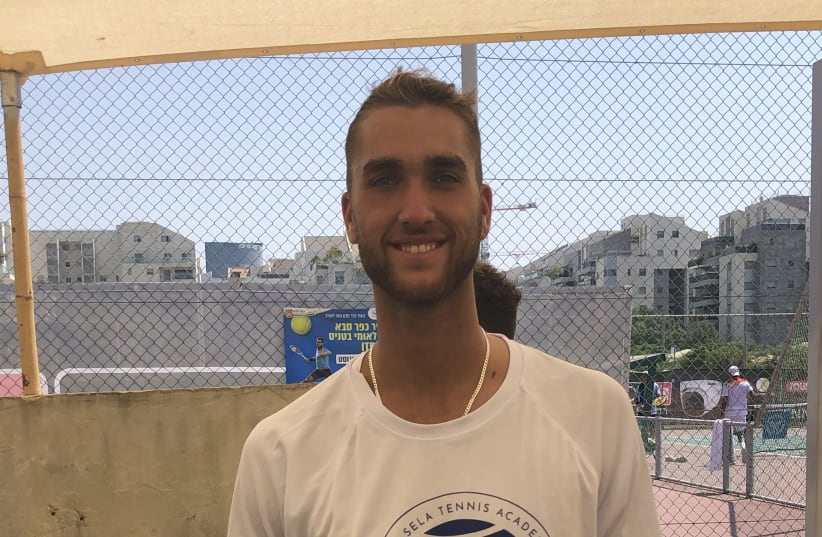The dozen or so hard-core tennis fans who stopped by the Toto Tennis Center in Kfar Saba between August 1 and 7, or the Bnei Herzliya Tennis Club in nearby Herzliya the following week, were treated to a chance to see some of Israel’s best young tennis players in action – all free of charge. They may have even gotten a glimpse of Israeli tennis legend, Dudi Sela, quietly watching 21-year-old Sahar Simon in action at the M15 Kfar Saba Open.
Simon fought hard all week in the blazing August heat. He defeated Nitzan Riklis 6-2, 2-6, 7-6 in a second-round match that lasted 3 hours and 20 minutes. Simon eventually advanced to the finals, where he defeated fellow Israeli Ben Patael 6-3, 4-6, 6-2.
The following week at the M15 Herzliya Open, Simon advanced to the quarterfinals before retiring with minor back issues while trailing Israeli Orel Kimhi 6-0, 2-0. Simon made a quick recovery and was in the main draw of the Aldershot, Great Britain, ITF World Team Tennis Tour. He lost in the first round to Filip Peliwo of Poland 6-3, 6-2.
Despite Simon’s successful past few months, he will not be playing in this year’s US Open in New York.
Simon, who trains with Sela at the Dudi Sela Tennis Academy in Tel Aviv, represents a crop of young talented Israelis who inhabit the lower rungs of the professional tennis world.
These young Israeli players range from No. 307 Yshai Oliel to No. 1,550 Yair Sarouk. They include such players as No. 425 Nicole Khirin, No. 435 Shavit Kimchi, No. 444 Daniel Cukierman, No.449 Ben Patael, and No.546 Edan Leshem.
Cukerman and Leshem have played on Israel’s Davis Cup team in past years.
While these players are better than millions of tennis players in the world, their current rankings – and the several hundred players ahead of them with even higher rankings – prevent them from competing in higher level tournaments with bigger payouts.
Fortunately, players have a mechanism to potentially advance and perhaps one day play in the US Open and other Grand Slams tennis events. Getting to that level requires perseverance, skill, luck and often the financial backing of parents and other angel investors.
Simon is currently ranked No. 651, an impressive jump from No. 803 one month ago. At the Kfar Saba Open, Simon and Sela spoke with The Jerusalem Post about such obstacles as lack of funding which makes it difficult for players to advance to the next level of professional tennis.
“This guy [Simon] pays for me, shoes and more,” noted Sela, indicating that his family supports his tennis career and that it is impossible for players who don’t have private funding.
Both laughed as they described how much it costs to enter the tournament (approximately 70 shekels) and how little the winner would take home.
“If you win Round 1, you have enough for hummus on pita,” Sela says, pointing to the nearby Hummus Eliyahu restaurant.
“If you win Round 2, you can have shwarma,” quipped Simon.
The International Tennis Federation (ITF) Men’s World Tennis Tour is working to do its part to help players advance to higher level tournaments with greater prize money. But the process is a long one.
The ITF provides entry-level professional tennis tournaments and a pathway between the ITF Junior World Tennis Tour and the elite levels of men’s professional tennis. The results of ITF tournaments are incorporated into the ATP Ranking, which enables professionals to progress to the ATP Challenger Tour and ATP Tour, and ultimately the Grand Slams. The Tour offers nearly 550 tournaments in 70 countries. They offer prizes at two levels – $15,000 and $25,000.
The August tournaments in Israel were considered “M15 tournaments,” meaning these “Futures” tournaments distribute $15,000 among all singles and doubles players. Futures tournaments are also where players can earn their first ATP points and get their names on the rankings. Each Futures tournament has 20 main draw spots and 48 qualifying spots. The acceptance list is based on ATP ranking points. These tournaments have a chair umpire, one line judge and players retrieving their own balls.
While the two tournaments were taking place in Kfar Saba and Herzliya, 15 similar M15s were taking place simultaneously in such places as Tbilisi, Georgia, Decatur, IL, Nottingham, England and Agadir, Morocco.
For the next three weeks, the tennis world turns its attention to the US Open Grand Slam tennis event in New York.
The qualifying tournament got under way on Tuesday, with 128 players vying for the 16 remaining spots in both the men’s and women’s singles draw. For tennis lovers on a tight budget, attending the US Open main draw (August 29-September 11 may prove to be challenging and costly. But the qualifying event taking place this week is a well-kept secret which allows fans to see top-level tennis for free.
As fans cheer on players with names like Nadal, Kyrgios, Williams and Osaka, and recall that last year’s winners, Daniil Medvedev and Emma Raducanu, each took home $2,500,000, it is useful to remember the thousands of talented lower level players slugging it out at 15 futures and four Challenger tournaments taking place at the same time – in Thailand, Bosnia-Herzegovina, Poland, Korea, Brazil, Egypt, Tunisia, etc.
Perhaps next year, with perseverance, luck and additional funding, more Israel tennis players will find their way to the US Open.
